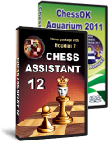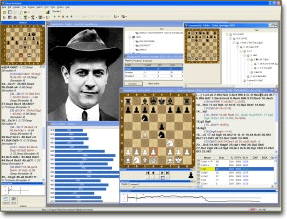Vous voulez organiser une formation Chess Assistant
Contactez-moi pour établir un devis !
Orazio Puglisi
Professeur et Entraineur FFE
06 14 35 15 52
oraziopuglisi@gmail.com
Télécharger Chess Assistant Lite
Chess Assistant – A Chess Database Powerhouse
 |
Chess Assistant is the world’s most advanced chess database system, combined with the world’s rating leader among chess engines, Houdini 2. Experience lightning fast searches, even in its biggest database with 5,1 million games. Automatic weekly updates, with thousands of new games, keep your database current. |
 |
| To get a better idea of Chess Assistant features you can watch short training videos.For online play, Chess Assistant offers you the choice of two popular chess servers: ChessOK Playing Zone and ICC. Chess Assistant has a long history of innovative and advanced analysis functions and now, with a built-in CQL search system, it has also taken the lead in advanced search functionality. | ||
Houdini 2 – The World Rating Lists Leader
Chess Assistant 12 comes with the Houdini 2 chess engine. Houdini 2 leads most independent computer chess rating lists by a considerable margin. No serious chess player can be without Houdini 2!
Opening Studies – Stay Organized with Opening Tables
 |
Chess Opening Encyclopedia 2011 contains rich theoretical material on all openings. It contains over 8.000 annotations from GM Kalinin and 40 million evaluations by the strongest engines. The detailed key system for all openings can be edited to suit your needs.
Opening Tables is a revolutionary way of creating, maintaining and studying your opening repertoire. Base your studies on the Opening Encyclopedia, customize it with your own moves and evaluations, enhance your favorite variations or create your own private opening repertoire. Working on your opening repertoire finally becomes the creative and enjoyable task it should be! Opening Test Mode allows you to test your knowledge and skills in openings. |
Analysis – Automatic, Manual and Background Analysis
Infinite analysis offers a wide range of options to customize the analysis to your needs:
Automatic opening annotation searches for novelty, adds expert annotations from the Opening Encyclopedia, CAP evaluations, inserts reference games etc. |
 |
Search for blunders automatically analyzes your games and annotates mistakes.
Multi-pass game analysis is an advanced game analysis method with flexible options to fine-tune each step of the search. You can even choose different engines for each phase of the game.
Analysis markers allow you to mark selected positions for automatic analysis at a later time.
Interactive analysis lets you to work with the engine, allowing it to analyze a position, and then guide it in its analysis without forgetting its conclusions.
Background Analysis is the most powerful position analysis tool in the extensive Chess Assistant arsenal. The analysis takes place in a background process, allowing you to continue working in Chess Assistant during the analysis. If you run into an interesting position, simply send it to background analysis while you continue your own analysis.
Background analysis can be split between two or more processors on the same computer or distributed automatically to several networked computers.
Tablebase analysis gives you a precise evaluation of endgames with 3-6 pieces (tablebases required).
Database Search – Standard Searches & CQL
Standard searches. When it comes to searching, you will not find a more powerful system than Chess Assistant. It offers all the types of standard searches you would expect for a chess database:
- Search by position, header, maneuvers, material, comments, etc.
- Novelty search.
- Advanced search with simultaneous specification of material in 12 regions on the board.
You can search through multiple databases and searches can be saved, enabling you to run them again at a later time. The program also keeps track of your most recent searches so you can quickly modify them and search again.
CQL (Chess Query Language). CQL is simply put the most powerful search method currently available for chess databases. If you have ever run into the limitations of standard search methods, CQL is for you. Mastering Chess Assistant’s CQL allows you to perform searches you could only dream of with any other chess database system.
Composite search allows you to store and organize your CQL queries into a hierachical structure, give them descriptive names, and set up a diagram of a typical position. This allows you to build a library of useful search criteria.
Classifiers – Organize Your Chess Data
- Icon. The icon serves as a reminder for the data contained in the folder.
- Text. A text description of the folder.
- Position. This could for instance be a critical position from an opening.
- Any search criteria, which allows games to be automatically classified with just a mouse click. This is of course a very powerful feature. An example is a classifier for endgames (pawn endgames, rook endgames etc.). Whenever you update your database, all you need to do is refresh the search in order to classify the endgames that occur in the new games.
- A list of games. Games can be included in the list either manually or automatically based on a search criteria.
- Chess tree. You can store chess trees in a classifier folder. This could for instance be detailed analysis results for an opening variation, while only the most important variations are shown in a game annotation.
- Another classifier, allowing practically unlimited flexibility in the structure of classifiers.
- Multimedia information: images, audio and video.
Chess Trees – State of the Art
Game Annotations and Global Annotations
Chess Assistant supports all types of game annotations, from simple text to multimedia content:
As useful as game annotations are, they have one drawback: They are tied to a particular game. When you run into the same position in a different game, how would you like to get a reminder saying: Hey, you have annotated this position before!” Well, in Chess Assistant you can annotate trees and tree annotations are “global”, meaning that they are displayed whenever the same position arises – in all databases.
Playing Features
If you want to play a game of chess against the computer, Chess Assistant offers a variety of engines and options:
- Wide selection of time controls and other playing options.
- Handicap engine included (Dragon).
- DGT board support with voice announcement of moves.
- Powerful opening book editor allows you to adapt the opening choice of the chess engine to your needs.
Online Play and Broadcasts: ChessOK Playing Zone and ICC
Database Compatibility: Chessbase and Chess Assistant
Chess Assistant supports all the most popular chess database formats, which means that your current database can most likely be used in Chess Assistant:
- Chess Assistant’s own efficient database format (CDP).
- Chessbase (CBH, readonly).
- PGN (Portable Game Notation).
- EPD (Extended Position Description).
The Aquarium interface also supports all these database formats, which allows you to share databases between Chess Assistant and Aquarium.
Optionally you can open and save databases in Zip-format in order to save space and conveniently send and receive databases by email.
Strong Chess Engine Support
Chess Assistant is compatible with most modern commercial and free chess engines. It supports a variety of protocols for communicating with chess engines, such as UCI, UCI2, WinBoard and MCS. In layman terms, this means that Chess Assistant gives you an unparalleled choice of chess engines for analysis and play.
- Support for Houdini, currently the strongest chess engine.
- Winboard support – Ruffian and Crafty are included, built-in support for over 50 others, available via free download.
- Hundreds of chess engines to choose from, including specialized mate solvers. Most of them are available via free download.
- Automatic test set processing with comprehensive reporting features.
Try it in action
Documentation & Updates
- Video lessons for Chess Assistant
- Chess Assistant Manual (English) in DOC
- Chess Assistant Manual (German) in DOC
- Chess Assistant Manual (English) in PDF
Vous voulez organiser une formation Chess Assistant
Contactez-moi pour établir un devis !
Orazio Puglisi
Professeur et Entraineur FFE
06 14 35 15 52
oraziopuglisi@gmail.com




